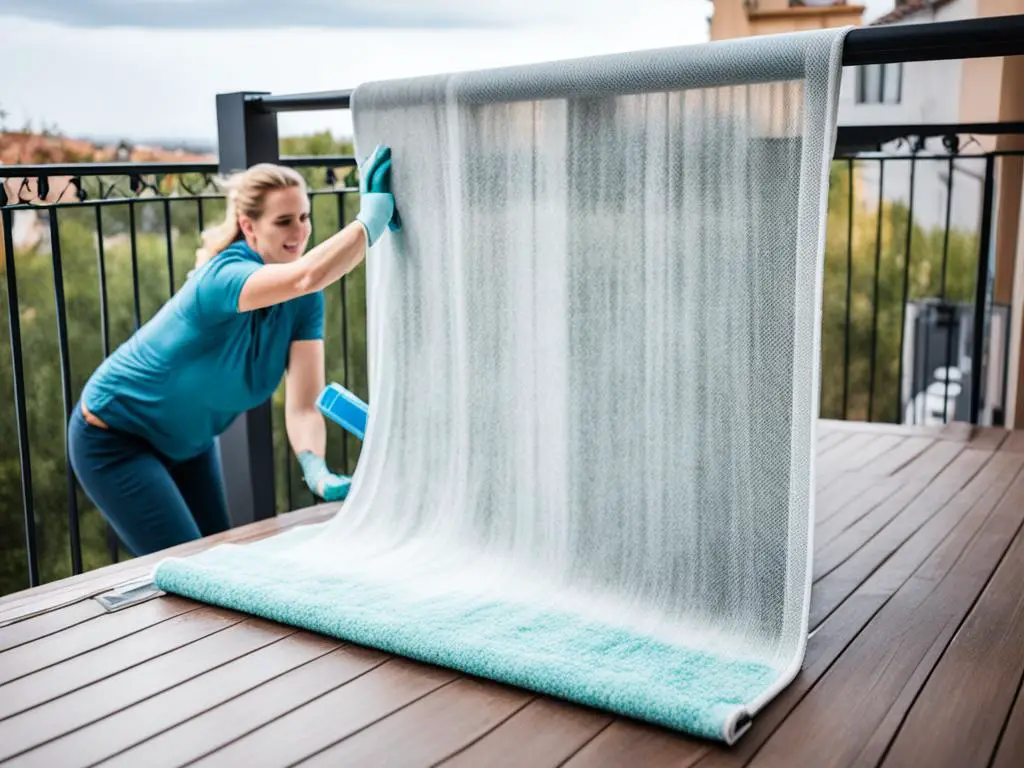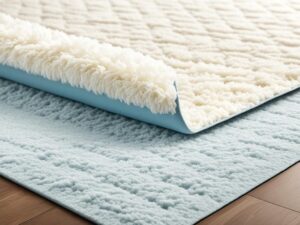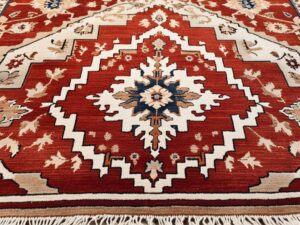Viscose rugs are a beautiful addition to any home decor. However, they require special care to keep them looking their best. Cleaning a viscose rug may seem daunting, but with the right techniques, you can easily clean it at home without causing any damage. In this article, we will provide you with easy tips and step-by-step instructions on how to clean and maintain your viscose rug.
Key Takeaways:
- Viscose rugs are delicate and require specific cleaning techniques.
- Spot clean spills and stains as soon as possible to prevent them from setting in.
- Avoid using harsh cleaners or excessive moisture on your viscose rug.
- Consider taking your rug to a professional cleaner every few years for a deep clean.
- Regular vacuuming and gentle brushing are essential for maintaining the appearance of your viscose rug.
How to Spot Clean a Viscose Rug
Spot cleaning is an important part of maintaining the appearance of your viscose rug. When you spot clean a viscose rug, it is crucial to treat the stain as quickly as possible to prevent it from spreading and damaging the fibers.
To spot clean a viscose rug, follow these simple steps:
- Blot the stain: Start by blotting the stain with a paper towel or clean rag. Avoid scrubbing or brushing the area, as this can push the liquid further into the rug.
- Mix a cleaning solution: Mix a citric or acetic acid solution with water or use white vinegar or mild dish soap diluted with water. These gentle solutions are effective in cleaning viscose rugs without causing damage.
- Gently scrub: Apply a small amount of the solution to the stain and gently scrub in the direction of the weave. Be careful not to apply too much pressure, as this can cause the fibers to become tangled or frayed.
- Softener mist: After cleaning the stain, mist the treated area with a fabric softener solution. This helps to keep the fibers soft and prevent them from becoming stiff or brittle.
- Drying: Lastly, dry the rug as quickly as possible to prevent any moisture from seeping into the fibers. Use a cool air setting on a hairdryer or simply air dry the rug away from direct sunlight.
Remember to fluff the fibers with a rug brush after spot cleaning to restore their appearance and maintain the overall beauty of your viscose rug.

Viscose Rug Care Instructions
Here are some additional care instructions to keep in mind when cleaning your viscose rug:
- Avoid using excessive water or moisture on your viscose rug, as this can cause the fibers to shrink or distort.
- Never use harsh chemicals or bleach when cleaning your viscose rug, as this can cause discoloration or damage to the fibers.
- Regularly vacuum your viscose rug to remove loose dirt and dust. Use a vacuum cleaner with a brush attachment or a vacuum cleaner specifically designed for delicate rugs.
- Rotate your rug periodically to prevent uneven wear and fading in high-traffic areas.
- Consider using a rug pad underneath your viscose rug to provide cushioning and prevent slipping.
By following these spot cleaning tips and care instructions, you can effectively clean and maintain your viscose rug, ensuring its longevity and keeping it looking its best.
When to Go to a Professional for Viscose Rug Cleaning
While it’s possible to clean your viscose rug at home, there are instances when it’s best to seek professional help for a thorough and effective cleaning. Professional viscose rug cleaning services offer expertise and specialized tools to remove deep-set stains and restore the rug’s beauty without causing damage to its delicate fibers.
One compelling reason to opt for professional cleaning is their use of dry-cleaning methods. Excessive moisture can be detrimental to viscose rugs, leading to browning or yellowing of the fibers. With dry-cleaning techniques, professionals can eliminate this risk and ensure a safe cleaning process.
If you have deep-set stains that you’re unable to remove through DIY methods, it’s advisable to consult a professional. They possess the necessary knowledge and experience to identify the right cleaning techniques and products for different types of stains on viscose rugs.
However, it’s crucial to exercise caution when deciding to have your viscose rug professionally cleaned. Frequent professional cleaning can also cause damage, as the cleaning agents used may be too harsh for the delicate fibers. It is generally recommended to have your rug professionally cleaned every two or three years, depending on the level of soiling and foot traffic it experiences.
Professional viscose rug cleaning can extend the lifespan of your rug and ensure its continued beauty. By combining their expertise with proper care and occasional professional intervention, you can enjoy the luxurious feel and elegant appearance of your viscose rug for many years to come.
Washing Tips for Viscose Rugs
When it comes to cleaning delicate viscose rugs, it’s essential to avoid using a washing machine as it can damage the rug and lead to stains. Instead, opt for gentle hand cleaning methods to preserve the rug’s shape and appearance. Follow these washing tips to keep your viscose rug looking clean and beautiful:
- Remove coarse dirt: Begin by using the top part of a vacuum cleaner to carefully remove any coarse dirt or debris from the rug’s surface. Take care not to apply too much pressure to avoid damaging the delicate fibers.
- Beat the rug outdoors: To eliminate deep-set dust particles and odors, take your viscose rug outdoors and gently beat it to dislodge any trapped dirt. This simple step can go a long way in refreshing the rug’s appearance.
- Brush gently: Use a soft brush made from natural hair to gently brush the rug’s surface in the direction of the fibers. This helps to remove surface dirt and restore the rug’s texture without causing damage.
- Treat stubborn stains: For stubborn stains, you can use a mixture of water and dishwashing detergent or a clear, non-colored glass cleaner. Apply the solution to the stained area and gently brush in the direction of the fibers. Alternatively, there are special cleaning agents available specifically designed for stained viscose rugs.
- Consult a specialist for chemical treatment: If you’re unsure about using any cleaning agents on your delicate viscose rug, it’s best to consult a specialist for advice on safe chemical treatments. They can provide guidance on suitable products and methods to treat specific stains and maintain the rug’s integrity.
By following these washing tips and handling your viscose rug with care, you can effectively clean it and ensure its longevity. Remember to always consult the rug’s care instructions and test any cleaning methods or products on a small, inconspicuous area first. With proper maintenance, your clean viscose rug will continue to enhance the beauty of your space.
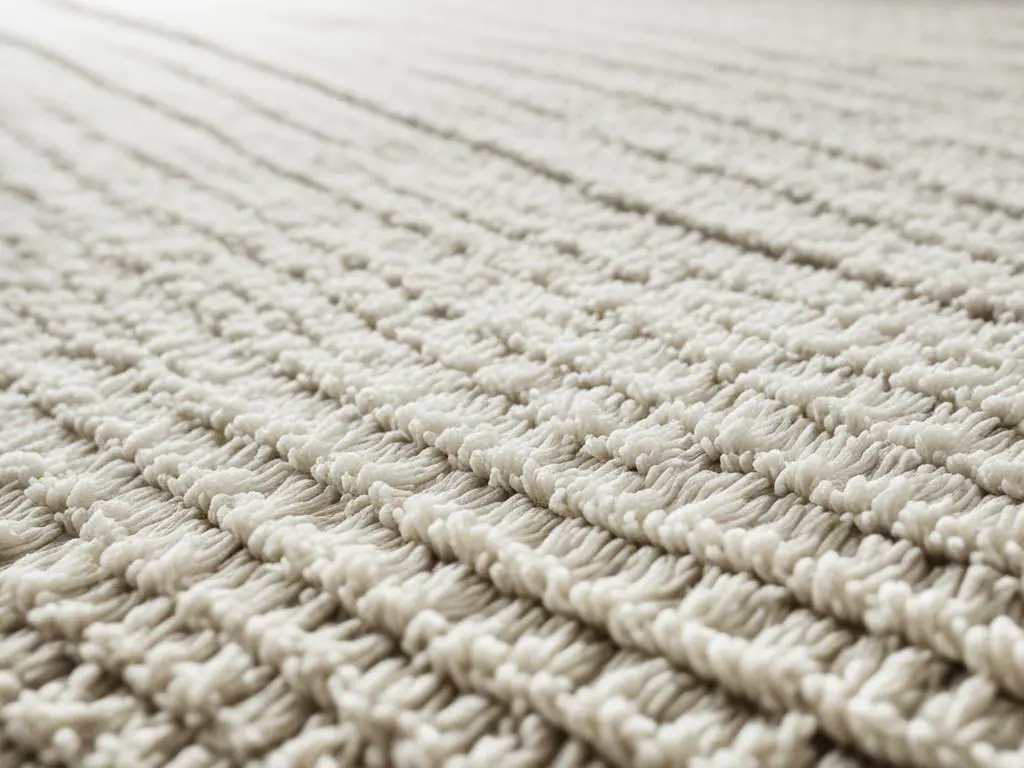
“Taking the time to clean your viscose rug by hand will help preserve its delicate fibers and extend its lifespan.”
Tips for Cleaning Different Types of Area Rugs
In addition to viscose rugs, there are other types of area rugs that require specific cleaning methods. Whether you have a wool, silk, or natural fiber rug, understanding the appropriate cleaning techniques will help you maintain its beauty and extend its lifespan.
Wool Rug Cleaning:
- Regularly vacuum your wool rug to remove dirt and dust particles.
- Consider professional cleaning once a year to remove deep-seated dirt and stains.
Silk Rug Cleaning:
- Gently vacuum your silk rug using a low-power setting to avoid damage to the delicate fibers.
- Ensure spills are promptly blotted to prevent staining. Avoid vigorous scrubbing.
Natural Fiber Rug Cleaning:
- Sweep or vacuum your natural fiber rug regularly to remove loose dirt and debris.
- Blot spills immediately with a clean cloth or towel to prevent permanent stains.
- Avoid using harsh chemicals, as they can fade or damage the natural fibers.
Comparative Analysis of Rug Cleaning Techniques
| Type of Rug | Cleaning Method |
|---|---|
| Wool Rug | Vacuum regularly and consider professional cleaning once a year. |
| Silk Rug | Gently vacuum and promptly blot spills to prevent staining. |
| Natural Fiber Rug | Sweep or vacuum regularly and immediately blot spills; avoid harsh chemicals. |
By following these tips and implementing the appropriate cleaning methods for different types of rugs, you can effectively maintain their appearance, prolong their lifespan, and enjoy their beauty for years to come.
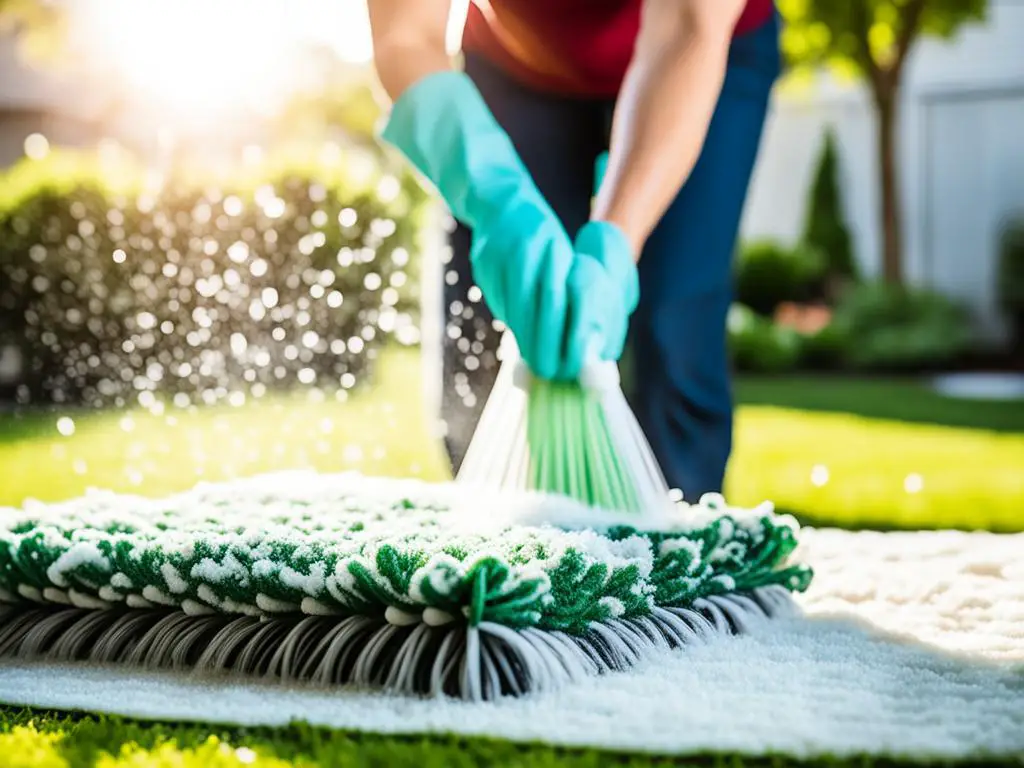
Conclusion
Cleaning a viscose rug may seem daunting, but with the right techniques, it can be done easily and effectively. Spot cleaning stains as soon as they occur is crucial to prevent them from setting in and causing permanent damage to the fibers. Using the proper cleaning solutions, such as a citric or acetic acid solution, white vinegar, or mild dish soap diluted with water, will help remove stains while being gentle on the delicate fibers of the rug.
Avoiding excessive moisture is essential when cleaning a viscose rug. Excessive moisture can cause the fibers to brown or yellow, leading to irreversible damage. It’s best to air dry the rug away from direct sunlight or use a cool air setting on a hairdryer to speed up the drying process. Additionally, misting the rug with a fabric softener solution after cleaning will help keep the fibers soft and maintain its overall appearance.
While it is possible to clean a viscose rug at home, it is also recommended to take it to a professional cleaner every few years for a deep clean. Professional cleaners have the expertise and tools to effectively remove deep-set stains and refresh the rug without causing damage. However, it’s important not to overdo it with professional cleaning as excessive cleaning can also harm the rug.
By following these easy tips and being mindful of the care instructions specific to viscose rugs, you can keep your rug looking its best for years to come. Regular maintenance, prompt spot cleaning, and occasional professional cleaning will ensure that your viscose rug remains clean, fresh, and beautiful, adding warmth and style to your home.
